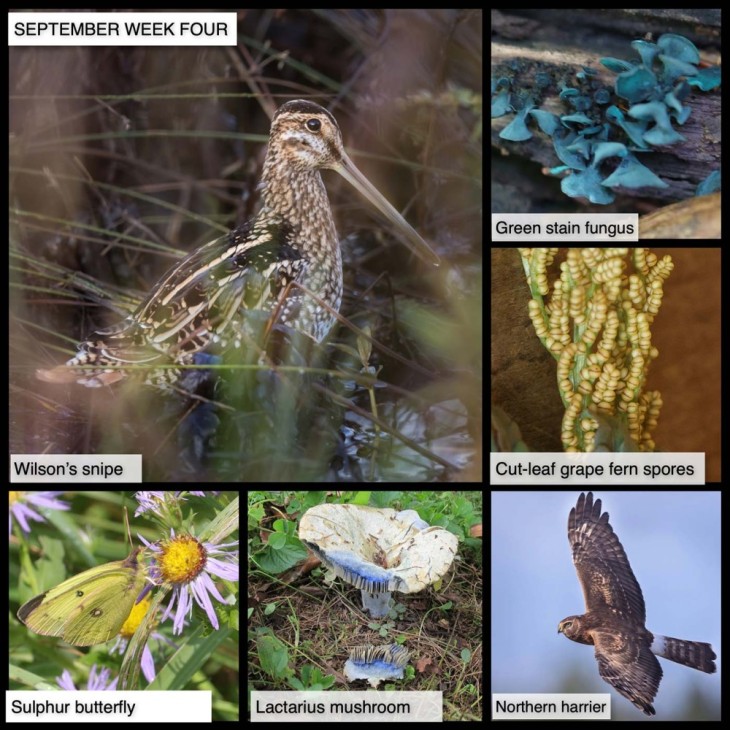This Week in the Woods, we found this Wilson’s snipe in a local wetland. These birds look like elongated versions of their distant cousins, American woodcocks (both in the sandpiper family), and have many similar behaviors and attributes, including flashy courtship flights and sensitive bill tips that help them forage for worms and other prey in the mud. Wilson’s snipes breed in our region, as well as in Canada. This time of year, the birds have begun migrating on moonlit nights, and this individual may well have been just passing through. Their winter range extends from the mid-Atlantic down to northern South America. Here’s a profile from Audubon.
Here are some other nature sights this week (clockwise):
Green stain fungus is a common decomposer of hardwood, and you’ll often find it in the form of what looks like dark green splashes on rotting logs. We’ve show that stain before in this series. What’s less common to see – although we’ve found multiple examples this week – are green stain’s tiny, teal colored fruiting bodies, which typically appear in clusters. Here’s a post from Mary Holland’s Naturally Curious blog, noting that woodworkers have used green stain fungus-discolored wood for decorative inlays.
Out in the meadow, we found beaded fronds of cut-leaf grape fern. These are the plant’s fertile fronds which, as Lynn Levine notes in her field guide, Identifying Ferns the Easy Way, have a flower-like appearance. When you find these, look for the small, finely cut sterile fronds low to the ground. They last all winter, but they change color as the weather cools, and are already starting to transition from green to dark bronze.
Migration season for northern harriers has also begun, although there’s still plenty of prey (rodents, small birds, etc.) for them in our region, and this bird may be a lingering local. Tig Tillinghast (also responsible for the snipe image above) took this image in a flooded field. Like other hawks, harriers are dimorphic, with females significantly outweighing males. Female and male harriers also radically differ in plumage; the females are mostly brown, while the less common males are gray and white with black wing tips. Here’s a profile from the Cornell Lab of Ornithology’s All About Birds site.
Peter Thompson shared this great image of a Lactarius mushroom, probably an indigo milky, that popped up near his home. Lactarius mushrooms, or milk caps, get their genus name from their trait of exuding milk-like fluid (latex) when they’re damaged. As shown in this image, the latex can be brightly colored. According to Timothy Baroni, in Mushrooms of the Northeastern United States and Eastern Canada, indigo milkies appear in our region between July and October.
Finally, if you walk by stands of late blooming goldenrod or aster, keep an eye out for sulphur butterflies. These fast-flying yellow butterflies are some of the last to remain in the air in autumn, and depending on the weather, they may linger as late as early November. It’s very hard to 100% identify different sulphur species, but based on this individual’s faint marginal spots at the back of its wings, pink lining, double spot, and yellow over wing, we’re pretty sure it’s a common species, clouded sulphur.
Our thanks to The Bailey Charitable Foundation and the Frank and Brinna Sands Foundation for helping to support this series.
In this difficult period, many of us find joy in observing local nature. This series, launched in April 2020, shares nature photographs taken in the past seven days, or in the same week in 2020, most within 15 miles of the Northern Woodlands office in Lyme, New Hampshire. We hope you enjoy using this grid as a prompt for your own explorations.
What are you seeing in the woods this week? Share your images with us on Facebook, or submit a special photo for possible inclusion in our monthly online Reader Photo Gallery.


